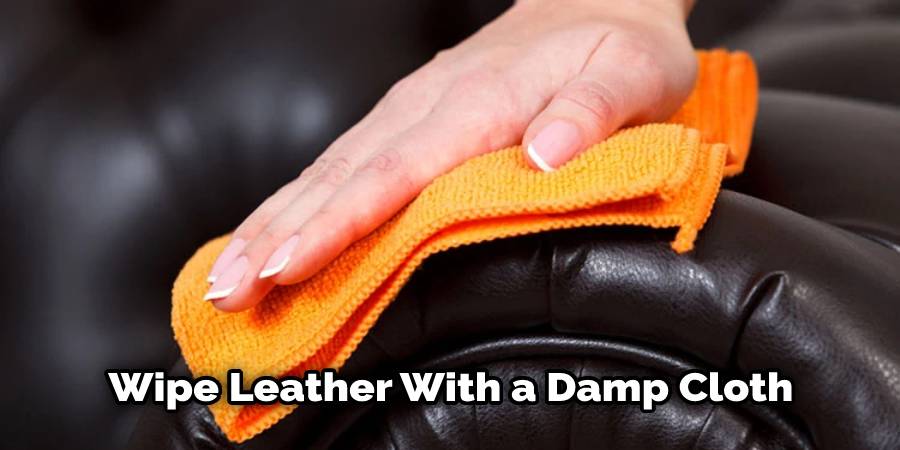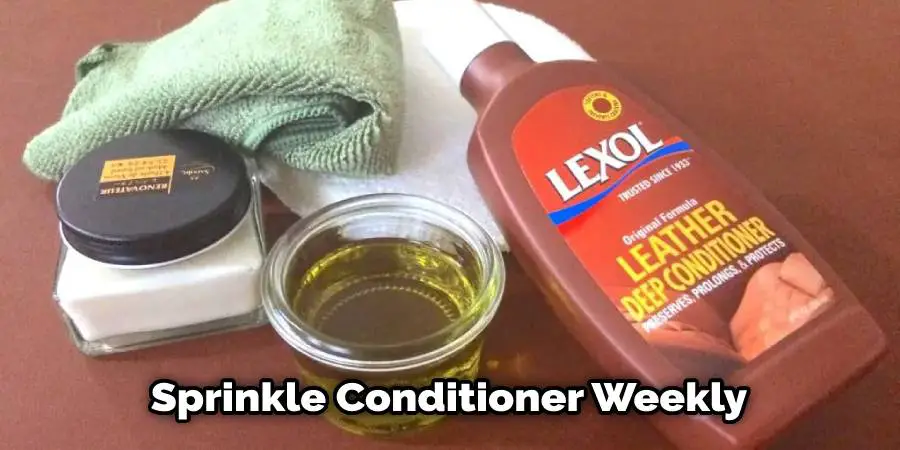Leather is a luxurious material that often adds an elegant touch to furniture and other accessories. However, if the sticky residue is left on leather, it can be difficult to remove. In this blog post, we will provide step-by-step instructions on how to remove sticky residue from leather. We will also offer tips for preventing the buildup of sticky residues in the future. Let’s get started!

Sticky residue can often be found on leather furniture. Sticky residue is generally caused by objects being placed onto the leather, leaving behind a damp mark that is difficult to remove. In addition to being difficult to remove, sticky residues often cause a buildup on the leather, ruining the leather’s appearance.
Things You’ll Need
- Bucket
- Warm Water
- Mild dish soap
- Leather conditioner
- Hairdryer
- Paintbrush
- Rags
- Soft clean cloth
How to Remove Sticky Residue From Leather Step by Step Instructions
Step 1: Before You Start
First, it’s important to note that the best way to deal with leather is usually not to have it get ruined in the first place.
– Leather needs moisture to stay strong and supple. Therefore, store leather products out of direct sunlight and away from heat sources whenever possible.
– To care for your leather items while they’re being used, be sure to wipe them down with a damp cloth after each use. This will remove any dirt or stains that might get caught in the fibers. And if you want your leather goods looking their best, follow up by brushing on some leather conditioner every few weeks – this helps keep the material clean and moisturized between cleanings.

Step 2: Cleaning Process
If despite all your best efforts, however, your leather good does get stained or sticky, it’s essential to clean the item as quickly as possible.
– The longer a stain sets in, the harder it will be to remove. If you’ve waited too long and the material is already starting to warp or discolor around a spill, a professional may need to step in and make repairs before you can treat the surface again.
– To clean up most messes (including watermarks) on leather goods like shoes or bags without damaging the materials more than necessary, gentle dish soap is often a good solution. However, before allowing the piece to air dry, be sure to rinse out the suds thoroughly – and wipe down any parts of your leather goods that you aren’t treating with soap.
However, if you’re dealing with a more sticky situation, it’s probably best to mix warm water with mild dish soap in a bucket until the foam reaches about one or two inches high. Then dip a rag or paintbrush into the soapy mixture and use it to scrub off as much excess residue as possible.
– Once all visible signs of gunk have been removed from your leather product, follow up by wiping away any excess moisture with a soft cloth – this will help prevent any unwanted discoloration and additional damage to your item.
– If you’re still concerned, however, about the surface of your leather goods becoming damaged during cleaning, you can always go with a less conventional method: hairdryer heat. With this approach, remember to keep the tool constantly moving over the sticky area for around 30 seconds at a time – this will help prevent any individual part from overheating and potentially warping or melting unpleasantly.

– Once you’ve broken up a significant portion of the residue, you can use a rag to wipe any excess material away. Then, continue moving your tool back and forth over the sticky area until it’s free from dirt and grime.
Step 3: Use Leather Conditioner
– To clean leather, it is best to apply the leather cleaner with a soft cloth. The leather cleaner will help dissolve any fats and grime left on your product’s surface.
– You can then wipe off any excess residue or dirt with a soft, dry cloth. If your item needs more deep cleaning, you can dampen the fabric slightly before continuing to remove stains and marks. Be sure to work in small sections at a time – this will make it easier for you to monitor how much dirt is being removed from the fibers without overdoing things and potentially damaging them!
– Once finished, safely remove all moisture using another dry cloth (this helps prevent spots).
Step 4: Protect Your Leather Goods After Cleaning
Once the soapy water has been wiped away from your leather goods and they’ve had time to air dry completely, you must follow up by treating the substance with a small amount of conditioner before returning it to storage.
- Leather conditioner is designed to rejuvenate old or worn-out leather products by helping to maintain the color and strength of the materials.
- The rule of thumb here is this: if you’re dealing with an item made out of genuine leather, you need to be sure that it’s only using conditioner every other cleaning – otherwise, your items might become too slippery or overly soft to operate safely.
- If your product is made out of vinyl, imitation leather (often called pleather), or another manufactured makeup, however, feel free to treat the material as often as necessary – generally sprinkle, this will likely mean applying a small amount of conditioner once per week.

- If you want to make sure that your leather goods don’t end up becoming damaged due to the cleaning and conditioning process, be sure to avoid using soap or heat on any surface area with existing coloration, patterns, or logos.
- If your item is large enough to where this isn’t an option, however, or if you’re dealing with a particularly stubborn stain on the surface of your leather goods, there are other options available for getting rid of tough marks.
We hope these steps will help in how to remove sticky residue from leather.
What Should You Not Clean Leather With?
While many different household cleaners and solvents can be used to clean leather, some should never be applied or used on your leather items. These include:
Alcohol, which can dry up and shrink leather fibers; benzene, a harsh chemical that evaporates quickly and leaves the leather too dry for proper care; abrasives like steel wool or anything made from synthetic materials (like a pencil eraser); and anything with lemon oil in it because of its acidity (e.g., furniture polish).
Leather can be expensive and sometimes difficult to care for, but with the right supplies and knowing what types of cleaners are safe to use on various kinds of leather, you’ll have a piece that looks new for years to come.
Frequently Asked Questions
Will Baking Soda Damage Leather?
Baking soda is highly abrasive, which may cause some light surface scuffing on the leather’s finish. However, this slight damage will be balanced out by removing the sticky adhesive residue. The benefit of using baking soda to remove the stickiness outweighs any minor damage to the leather.
What Happens if You Use Goo Gone on Leather?
Goo Gone might be great for removing sticky residues, but it isn’t the best product to use on leather. Because Goo Gone is mainly made of petroleum-based chemicals, which can also damage leather, instead of using Goo Gone, opt for a citrus oil-based cleaner like Orange Glo or Endust, or something that’s meant specifically for cleaning leather.
Conclusion
It is essential to know how to remove sticky residue from leather to maintain its appearance and quality. Whether the residue is caused by a sticker or tape, these methods will help you clean it up quickly and easily. If you follow the steps above, the chances are good that your leather will be free of any sticky mess. However, before applying any of these methods, test them on a small, inconspicuous part of the leather for at least an hour or two so that you can ensure they won’t damage the material.

